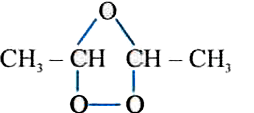Product of the given reaction CH3CH2−CH=CH3SiO2−−→ will be
CH3−OH∣CH−CH=CH2
OH∣ CH2−CH2−CH=CH2
CH3−CH2−C∣∣O−CH3
CH3−CH2−C∣∣O−CHO
The correct Answer is:A
To solve the reaction of 1-butene (CH₃CH₂-CH=CH₂) with SiO₂, we will follow these steps:
Step 1: Identify the Reactant
The reactant is 1-butene, which has the structure:
CH3CH2CH=CH2
Step 2: Understand the Role of SiO₂
Silica (SiO₂) acts as a catalyst in this reaction and is known for facilitating selective hydroxylation, specifically allylic hydroxylation. This means that it will introduce a hydroxyl (-OH) group at the allylic position relative to the double bond.
Step 3: Determine the Allylic Position
In 1-butene, the double bond is between the second and third carbon atoms. The allylic positions are the carbon atoms adjacent to the double bond. Therefore, the allylic positions are:
- The carbon atom at position 2 (CH₂)
- The carbon atom at position 3 (CH)
Step 4: Perform the Hydroxylation
In allylic hydroxylation, the hydrogen atom from the allylic carbon (position 2) is replaced with a hydroxyl group (-OH). The reaction can be represented as follows:
- The hydrogen atom from the second carbon (CH₂) is removed, and an -OH group is added.
The product will then be:
CH3CHOHCH=CH2
Step 5: Write the Final Product
Thus, the final product of the reaction is:
CH3CHOHCH=CH2
Conclusion
The product of the reaction of 1-butene with SiO₂ is:
CH3CHOHCH=CH2
The reactant is 1-butene, which has the structure:
CH3CH2CH=CH2
Silica (SiO₂) acts as a catalyst in this reaction and is known for facilitating selective hydroxylation, specifically allylic hydroxylation. This means that it will introduce a hydroxyl (-OH) group at the allylic position relative to the double bond.
In 1-butene, the double bond is between the second and third carbon atoms. The allylic positions are the carbon atoms adjacent to the double bond. Therefore, the allylic positions are:
- The carbon atom at position 2 (CH₂)
- The carbon atom at position 3 (CH)
In allylic hydroxylation, the hydrogen atom from the allylic carbon (position 2) is replaced with a hydroxyl group (-OH). The reaction can be represented as follows:
- The hydrogen atom from the second carbon (CH₂) is removed, and an -OH group is added.
CH3CHOHCH=CH2
Thus, the final product of the reaction is:
CH3CHOHCH=CH2
The product of the reaction of 1-butene with SiO₂ is:
CH3CHOHCH=CH2
Topper's Solved these Questions
Similar Questions
Knowledge Check
What is the final product of reaction
CH3−C≡CHNa−−→CH3−CH2−I−−−−−−−−→ .ACH2=CH−CH2−CH3BCH3−CH2−C=C−CH2−CH3CCH≡C−CH2−CH2−CH3DCH3−C≡C−CH2−CH3Product of the given reaction
CH3−CH=CH−ChO3/CH2Cl2−−−−−−−→−78∘C
will be :ACH3−CHOBCH3−COOHCCH3−CH| OH−CH| OH−CH3D
Product formed in the following reaction is CH3CH2CH(OH)CH3H2SO4−−−→
ACH3CH=CHCH3 predominatesBCH2=CHCH2CH3 predominatesCBoth are formed in equal amountsDThe amount of production depends on the nature of catalyst
Write the structures of the products of the following reactions :
(i) CH3−CH=CH2H2O/H+−−−−−→ (ii)
(iii) CH3−CH2−CH∣CH3−CHONaBH4−−−−→
View SolutionWhat is the final product of the following reaction?
CH3CH=CH2+NBS→ A AgCN−−−→B (Major)
View SolutionWhat is the major bromination product in the following reaction ?
CH3−CH=CH−CH3+Brhv−−→
View SolutionIdentify the products in the following reaction
3CH3CH=CH2BH3−−→XH2O2/OH−−−−−−−−→products+H3BO3
View SolutionIn the given reaction CH3−CH2−CH2−O−CH2−CH3Conc.Hl−−−−→(X)+(Y)
View Solution
